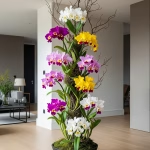Plant hardy hibiscus in spring after the last frost date when soil temperatures reach 60°F or higher. These plants need time to establish before winter dormancy.
Planting steps:
- Dig a hole twice as wide as the root ball and the same depth
- Gently loosen circling roots to encourage outward growth
- Place the plant at the same depth it was growing in the container
- Backfill with amended soil and water thoroughly
- Apply 2-3 inches of mulch around the base, keeping it away from the stem
Planting Tropical Hibiscus
Tropical hibiscus can be planted outdoors after all danger of frost has passed, or grown year-round in containers that can be moved indoors during winter.
Container planting tips:
- Use pots at least 12 inches wide with drainage holes
- Choose high-quality potting mix designed for flowering plants
- Ensure adequate drainage with pot feet or saucers
- Select containers that complement your hibiscus variety’s mature size
Essential Hibiscus Care Requirements
Watering Hibiscus Plants Properly
Consistent moisture is key to growing gorgeous hibiscus, but overwatering can be just as damaging as drought. These plants prefer evenly moist soil that never becomes waterlogged.
Watering guidelines:
- Water deeply when the top inch of soil feels dry
- Provide 1-2 inches of water weekly during growing season
- Water early morning to reduce disease pressure
- Mulch around plants to retain moisture and suppress weeds
- Reduce watering frequency in fall for hardy varieties
Signs of watering problems:
- Overwatering: Yellow leaves, root rot, fungal issues
- Underwatering: Wilting, brown leaf edges, bud drop
Fertilizing for Maximum Blooms
Hibiscus plants are heavy feeders that require regular fertilization to produce their spectacular blooms. The key is providing balanced nutrition throughout the growing season.
Fertilizer recommendations:
- Use balanced fertilizer (10-10-10 or 12-12-12) monthly during growing season
- Apply slow-release granular fertilizer in spring for season-long feeding
- Supplement with liquid fertilizer every 2-3 weeks during peak growing season
- Add Epsom salt monthly to provide magnesium for healthy foliage
Organic fertilizing options:
- Compost applied as side-dressing in spring and mid-summer
- Fish emulsion diluted according to package directions
- Bone meal worked into soil at planting time
- Worm castings as a gentle, long-lasting nutrient source
Pruning Hibiscus for Shape and Health
Proper pruning encourages bushier growth, more blooms, and better plant health. The timing and technique vary between hardy and tropical varieties.
Hardy hibiscus pruning:
- Cut back to 4-6 inches above ground in late fall or early spring
- Remove dead, damaged, or crossing branches anytime
- Pinch growing tips in early summer to encourage branching
- Deadhead spent blooms to encourage continued flowering
Tropical hibiscus pruning:
- Prune lightly throughout the growing season to maintain shape
- Remove up to one-third of the plant’s height in late winter
- Pinch or cut back leggy branches to promote bushier growth
- Remove suckers and water sprouts that drain energy from the main plant
Common Hibiscus Problems and Solutions
Pest Management
Several pests can affect hibiscus plants, but most are easily managed with proper identification and treatment.
Aphids: Small, soft-bodied insects that cluster on new growth and buds. Control with insecticidal soap, neem oil, or beneficial insects like ladybugs.
Spider mites: Tiny pests that cause stippled, yellowing leaves and fine webbing. Increase humidity, spray with water, or use miticide sprays.
Whiteflies: Small, white flying insects that feed on leaf undersides. Use yellow sticky traps, insecticidal soap, or beneficial insects for control.
Hibiscus beetles: Metallic green beetles that eat flowers and foliage. Hand-pick beetles or use targeted insecticides during heavy infestations.
Disease Prevention and Treatment
Preventing diseases is easier than treating them, so focus on creating optimal growing conditions for your hibiscus plants.
Fungal diseases: Caused by overwatering, poor air circulation, or overhead watering. Improve drainage, space plants properly, and water at soil level.
Bacterial leaf spot: Dark spots on leaves with yellow halos. Remove affected foliage, improve air circulation, and avoid overhead watering.
Root rot: Usually caused by overwatering or poor drainage. Ensure proper drainage, reduce watering frequency, and consider fungicide treatments.
Troubleshooting Common Issues
Bud drop: Usually caused by stress from changes in watering, temperature, or location. Maintain consistent care and avoid moving plants unnecessarily.
Yellow leaves: Can indicate overwatering, underwatering, nutrient deficiency, or natural aging. Evaluate care practices and adjust accordingly.
Poor flowering: Often results from insufficient light, over-fertilizing with nitrogen, or inadequate water. Ensure 6+ hours of sunlight and balanced fertilization.
Seasonal Hibiscus Care Calendar
Spring Care (March-May)
- Plant hardy hibiscus after last frost
- Begin fertilizing established plants
- Start watering schedule as growth begins
- Prune tropical varieties before active growth
- Watch for new pest activity
Summer Care (June-August)
- Maintain consistent watering schedule
- Continue monthly fertilization
- Deadhead spent blooms regularly
- Monitor for pest and disease issues
- Provide afternoon shade in extreme heat
Fall Care (September-November)
- Reduce fertilization frequency
- Begin preparing tropical varieties for indoor storage
- Continue watering until dormancy begins
- Collect seeds from favorite varieties
- Plan next year’s hibiscus additions
Winter Care (December-February)
- Store tropical hibiscus indoors or in protected areas
- Reduce watering for dormant hardy varieties
- Plan garden improvements and new varieties
- Order plants and seeds for spring planting
- Maintain indoor tropical hibiscus with adequate light
Propagating Hibiscus Plants
Growing from Cuttings
Propagating hibiscus from cuttings is an excellent way to expand your collection or share favorite varieties with friends.
Cutting propagation steps:
- Take 4-6 inch cuttings from healthy, non-flowering shoots
- Remove lower leaves, leaving 2-3 pairs at the top
- Dip cut end in rooting hormone (optional but helpful)
- Plant in well-draining potting mix
- Keep soil moist and provide bright, indirect light
- Roots typically develop in 3-4 weeks
Growing from Seeds
Starting hibiscus from seeds is rewarding but requires patience, as plants may take 2-3 years to reach flowering size.
Seed starting process:
- Soak seeds in warm water for 24 hours before planting
- Plant in seed-starting mix, covering lightly
- Maintain soil temperature of 70-75°F for best germination
- Provide bright light once seedlings emerge
- Transplant to larger containers as plants grow
Companion Planting with Hibiscus
Hibiscus plants make excellent focal points in mixed plantings. Choose companions that complement their growing requirements and enhance their tropical appearance.
Excellent companions:
- Cannas: Bold foliage and colorful flowers
- Elephant ears: Dramatic tropical foliage
- Lantana: Heat-tolerant with continuous blooms
- Pentas: Attracts butterflies and hummingbirds
- Caladiums: Colorful foliage for shadier spots
Choosing the Best Hibiscus Varieties
Outstanding Hardy Hibiscus Varieties
‘Luna Series’: Compact plants with enormous 8-inch blooms in white, pink, and red. Excellent for smaller gardens.
‘Summerific Series’: Heat-tolerant varieties with flowers up to 7 inches across in various colors including bicolors.
‘Midnight Marvel’: Deep red flowers contrast beautifully with dark burgundy foliage.
‘Kopper King’: Coral-pink blooms with copper-colored leaves create a stunning combination.
Spectacular Tropical Hibiscus Varieties
‘Double Red’: Classic red double flowers on compact, bushy plants.
‘Hula Girl’: Yellow flowers with red centers and ruffled petals.
‘Painted Lady’: Pink flowers with darker pink veining and ruffled edges.
‘Cajun Cocktail’: Coral-orange blooms with deeper orange centers.
Hibiscus in Landscape Design
Hibiscus plants can serve multiple roles in landscape design, from specimen plants to privacy screens. Their large, colorful blooms make them natural focal points that draw attention and create visual interest.
Design applications:
- Specimen plantings: Single plants as garden focal points
- Mass plantings: Groups of the same variety for dramatic impact
- Mixed borders: Combined with other tropical or cottage garden plants
- Container gardens: Portable tropical displays for patios and decks
- Privacy screens: Tall varieties for natural barriers
Overwintering Hibiscus
Hardy Hibiscus Winter Care
Hardy hibiscus naturally die back to the ground each winter, making them relatively low-maintenance during the dormant season.
Winter preparation:
- Stop fertilizing 6-8 weeks before first frost
- Gradually reduce watering as growth slows
- Cut back stems after first hard frost
- Apply 3-4 inches of mulch over the root zone
- Mark plant locations to avoid accidental damage
Tropical Hibiscus Winter Storage
Tropical hibiscus require protection from freezing temperatures and can be overwintered using several methods.
Indoor storage options:
- Houseplant method: Keep plants actively growing near bright windows
- Dormant storage: Allow plants to go dormant in cool, dark basements
- Garage storage: Store in unheated but frost-free garages with minimal light
Preparation for indoor storage:
- Gradually acclimate plants to lower light conditions
- Inspect for pests and treat if necessary
- Reduce watering frequency as growth slows
- Prune back by one-third to make handling easier
- Move indoors before first frost threatens
Attracting Wildlife with Hibiscus
Hibiscus flowers are magnets for pollinators and other beneficial wildlife. Their large, colorful blooms and abundant nectar make them excellent choices for wildlife gardens.
Wildlife attracted to hibiscus:
- Hummingbirds: Especially drawn to red and orange varieties
- Butterflies: Many species visit hibiscus for nectar
- Bees: Native bees and honeybees appreciate the pollen and nectar
- Beneficial insects: Predatory insects that help control garden pests
Sustainable Hibiscus Growing Practices
Growing gorgeous hibiscus doesn’t have to come at an environmental cost. Implementing sustainable practices benefits both your garden and the broader ecosystem.
Eco-friendly practices:
- Use organic fertilizers and pest control methods
- Collect rainwater for irrigation during dry periods
- Compost plant debris and fallen leaves
- Choose native or adapted varieties when possible
- Avoid chemical pesticides that harm beneficial insects
Conclusion: Your Journey to Gorgeous Hibiscus
Growing gorgeous hibiscus plants rewards gardeners with spectacular blooms, tropical ambiance, and the satisfaction of nurturing these magnificent plants. Whether you choose hardy varieties for permanent landscape installations or tropical varieties for container gardens, success comes from understanding their basic needs: plenty of sunlight, well-draining soil, consistent moisture, and regular fertilization.
Start small with one or two varieties to gain experience, then expand your collection as your confidence grows. With proper care and attention to their specific requirements, hibiscus plants will reward you with months of stunning blooms that transform any garden space into a tropical paradise.
Remember that gardening is a journey of continuous learning. Each growing season brings new insights and opportunities to refine your hibiscus-growing skills. Embrace the process, celebrate your successes, and learn from any challenges you encounter along the way.
Your gorgeous hibiscus garden awaits – it’s time to start growing these magnificent plants and enjoying the spectacular blooms they provide season after season.


